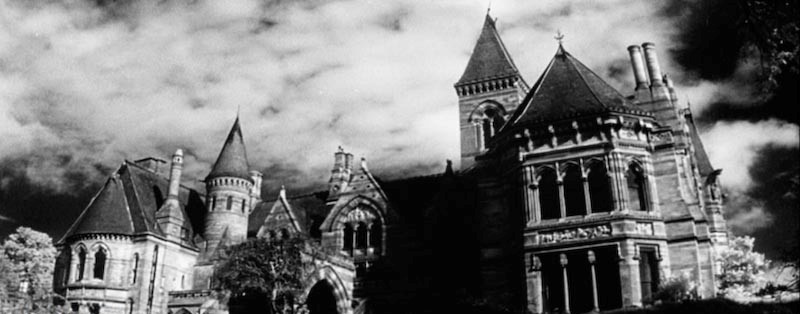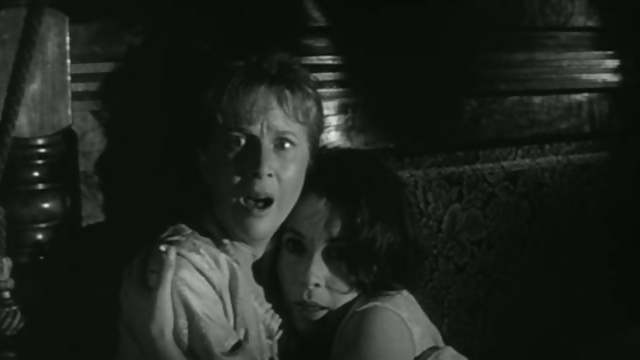“Hill House had stood for 90 years, and might stand for 90 more…”
British actor Richard Johnson intoned those words 50 years ago in the opening shot of Robert Wise’s 1963 The Haunting, which itself remains standing as the greatest haunted house film ever made and one of the best horror films of all time. Based on the novel The Haunting of Hill House by Shirley Jackson – a masterpiece of the genre in its own right – Wise’s film does its source material exquisite justice and is a genuinely unsettling and frightening cinematic experience that exudes a terrifying power to this day.
The best thing about The Haunting – well, there are so many great things about it, but let’s start with this: nothing is ever explained. Yes, the history of Hill House is outlined in that opening voiceover and its accompanying montage, and it’s an unsavory one indeed. But there’s no reason given for why so many horrible things have happened within its labyrinthine walls, except that the house itself was “born bad.” By the film’s end, no ghosts have been exorcised, no secret motivations uncovered, and the house – which Johnson’s Dr. Markway refers to as “deranged” at one point – is as malevolent, implacable and unknowable as it was at the beginning.
That’s the problem with far too many horror films released these days – there’s a need on the part of many of the filmmakers to explain what’s behind the horrific goings-on or give some sort of logical motivation for the supernatural occurrences. Exhibit A is the 1999 version of this same story, directed by Jan de Bont, which came up with a ludicrous back story that removed all of the house’s mystery and turned the whole tale into a family dispute. Coming up with a reason for the occurrences in Hill House ultimately made the house far less frightening (and let’s not even start on that woeful production’s overuse of CG and visual effects to make the implicit explicit).
The modern-day need to explain everything – even Hannibal Lecter eventually got a tragic personal history – does not appear anywhere in the Robert Wise film. The events that take place in the house – loud bangings, cryptic messages written on the walls, doors that open, close and expand – lack any coherence or overriding rationale. They just happen. They don’t make sense, and it’s the inability to decode any sort of reasoning behind them makes them that much more disturbing. One cannot argue with the insane, especially when it’s made of stone.

The plot is simple and direct. Markway, a paranormal researcher, sets out to investigate the house with psychic Theodora (Claire Bloom), property heir Luke Sannerson (Russ Tamblyn) and Eleanor “Nell” Lance (Julie Harris). The latter, who has spent 11 years caring for her recently deceased invalid mother, is mentally unstable but has been invited because of paranormal occurrences in her past. Paranormal activity begins almost as soon as they set foot in the mansion, but it soon becomes clear that Eleanor – the weakest of the four – is the main target of the house’s psychological assault.
In keeping with the idea that Hill House is not sane – this is a house without a single right angle in it – Wise and his director of photography Davis Boulton, working in glorious black and white, keep the viewer off-balance with low-angle shots, Dutch angles, unexpected close-ups and lots of deep focus, not to mention vast swaths of darkness and shots of long, silent, brooding hallways. Many standard rules of establishing time and place are violated, with the result that one never knows exactly how the rooms in the house connect nor even whether it’s day or night outside.
The cast is impeccable, but Julie Harris stands alone as Eleanor, wounded, inexperienced both sexually and socially, and gradually losing touch with reality. Already drained of normal life experience by having to care for her mother – and becoming a shut-in herself – and being browbeaten by her sister, Eleanor is the perfect receptacle for the corrupting influence of Hill House, and while it’s clear that there are supernatural forces at work in the mansion, Harris’ complex performance as she skates along the edge of madness and hysteria nevertheless makes the viewer at least consider that the whole thing is happening inside her fractured mind.
But having the story be a vivid hallucination inside the crumbling mind of a pitifully damaged woman would be a rational conclusion. The rational and the logical have no place at Hill House, where nothing can be explained and there is no one, alive or dead, to reason with. Whatever walks there, walks alone, and its footsteps still reverberate 50 years later through the brooding halls of cinema’s most terrifying haunted house.
The Haunting is out now on Blu-ray for the first time ever. The movie looks crisper and more detailed than ever, but sadly for its 50th anniversary, the only extra is a theatrical trailer.

